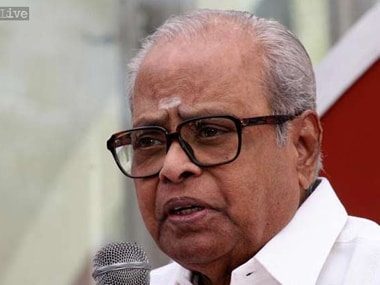The biggest risk of reminiscing about film maker K Balachander, who passed away on Tuesday, is the trap of cliches and idolisation, but as an artist who had straddled multiple disciplines and genres of Tamil cinema for close to five decades, he certainly tests one’s ability to fathom diversity. His nine national awards, countless Filmfare awards, the coveted tiles such as Padma Shri and Dada Saheb Phalke award and the celebrated trivia that he introduced both superstar Rajinikanth and Kamal Haasan (in an adult role) along with a 100 others including music composer AR Rahman speak of the enormity of his stature as a doyen of Indian cinema. At a closer look, what stuns one is the depth of his art and oeuvre, which are so diverse, true to his times, socially relevant and honest. He was a successful commercial film maker, who also wrote for the big stars of yore such as MG Ramachandran and Shivaji Ganeshan, yet had a body of work that included the pick of socio-politically sensitive films in India. It’s also remarkable that the man who forayed into movies in 1964 continued to successfully write and direct till 2006. He was indeed a man of many parts and any attempt to curate his repertoire will be met with a glut of options. [caption id=“attachment_2012991” align=“alignleft” width=“380”]  Courtesy: ibn live[/caption] Perhaps some of his best films came in the 1970s and the 80s, when the rest of India also witnessed the emergence of a new form of contemporary cinema that tried to challenge the mainstream. His Arangetram released in 1973 was a shocker and catapulted him into a different league at the regional and national levels. The movie was about a Brahmin girl getting into prostitution to support her family. It was social drama, but dealt with a subject that was anathema to the generally held values, particularly of the Brahmins. The movie was bold in terms of content and picturisation, but went on to become a commercial success. Incidentally, this was the movie that saw the debut of a grown up Kamal Haasan. The star would remain eternally grateful to Balachander for this break and would go on to play the lead role in many of his future films. A year later, Balachander produced another strongly woman-centric film Aval Oru Thodarkathai, which dealt with a working woman who struggles to support her thankless family. Other than the performance of the protagonist, it was noted for its poignant writing. The movie, along with its songs, also made waves in Malayalam. It was followed up my another out-of-the-box film, the national award winning Apoorva Ragangal that dealt with the relationship between a young man and much older (and married) woman. With additional twists, the movie had a complex plot in terms of human relationships that had rarely been depicted in Indian cinema. Rajinikanth, a remarkably unusual face then, got his break through this film. His 1977 movie Avargal also had a strong woman lead who was torn between her lover and former husband. The movie was considered radical for the 1970s. The same decade saw movies that dealt with the drama of human relationships such as Manmadha Leelai and Munru Mudichu, as he continued at his prolific best, writing and directing four to five films in a year. If the 1970s saw strong woman characters and complex human relationships, in the 1980s, he was particularly sensitive to the socio-political reality of the decade. Along with the regular fare that included commercial blockbusters such as Ek Duje Keliye, and Punnagai Mannan, both featuring Kamal Haasan, he made movies such as Varumayin Niram Sivappu, which was a troubling portrayal of unemployment of educated youth, and Thanneer Thanneer, that dealt with drought. The immense range of themes and styles of his films is awe-inspiring. There is not a single genre that he hasn’t handled and his films were never predictable. The emotional dramas and strongly women-led features of the 1970 were also accompanied by light hearted comedies and love stories. Similarly the highly political Thannneer Thannneer was followed by a heart-wrenching love story, Ek Duje Keliye, and the intense family drama, Sindhu Bhairavi. Equally impressive was his prolificacy. For instance, in 1971, as many as seven films, including two each in Hindi and Telugu, featured him either as a director or writer. He had made movies in all the south Indian languages and in Hindi. In fact, his first Hindi feature as a writer was as early in 1964. Till 2006, when he made his last movie, the count of his titles both as a writer and director was 101. His contribution to Indian cinema is also in the form of a large number of actors and technicians. He literally launched and sustained the careers of many who went onto become the mainstay of cinema in the south and the rest of India. Unsurprisingly, he is highly revered in the industry with a number of film makers and actors of different generations considering him their guru and reference point, although some of them might not have ever worked with him or trained under him. One such tribute came from a new generation film maker Sudhish Kamath, who tweeted: “KB: Greatest Indie film maker ever. Created Rajnikant & Kamal Haasan. Inspired hundreds of filmmakers including me. Wrote strong women. RIP, Sir.” Balachander meant different things to different people. His is a legacy that is hard to recreate.
Balachander meant different things to different people. His is a legacy that is hard to recreate.
Advertisement
End of Article


)
)
)
)
)
)
)
)
)



